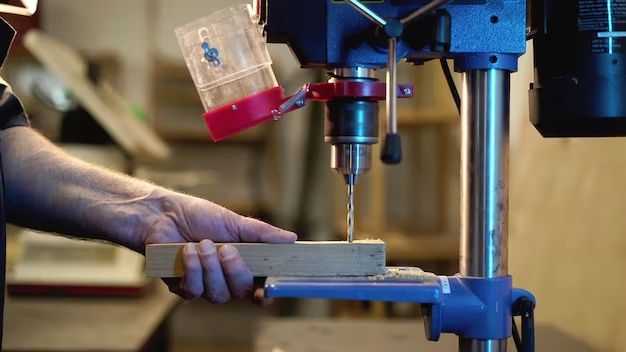Riveting machines are vital tools in industrial manufacturing, used to join two or more materials permanently by inserting and deforming rivets. This process creates strong, durable joints without welding or adhesives, making it essential in industries like automotive, aerospace, construction, and electronics.
Originally developed for manual operations, riveting has now evolved into a highly automated and precision-driven process, enabling manufacturers to achieve consistent quality, speed, and strength in production lines.
Modern riveting machines integrate pneumatic, hydraulic, or electric systems, ensuring accuracy, repeatability, and energy efficiency—key requirements in today’s smart manufacturing environments.

Importance: Why Riveting Machines Matter in Modern Manufacturing
Riveting remains a preferred fastening technique because it balances strength, reliability, and cost-efficiency. It plays a major role in mass production and lightweight component assembly, especially where welding or adhesives are impractical.
Key Advantages of Riveting Machines:
-
High Strength & Durability: Creates long-lasting joints that resist vibration and fatigue.
-
Versatility: Suitable for metals, plastics, and composites.
-
Automation-Friendly: Easily integrated into robotic production systems.
-
Low Maintenance: Minimal downtime and easy operation.
-
Precision Joining: Ensures consistent joint quality across high-volume production.
From aircraft fuselages to automobile frames, riveting machines form the backbone of industrial assembly lines worldwide.
Types of Riveting Machines and Their Applications
| Type | Description | Common Applications |
|---|---|---|
| Impact Riveting Machines | Use mechanical force to set rivets in one stroke. | Automotive components, furniture, and electrical equipment. |
| Orbital Riveting Machines | Employ orbital motion for smooth, controlled deformation. | Electronics, precision instruments, and delicate assemblies. |
| Radial Riveting Machines | Use a combination of rotation and pressure for high-quality joints. | Aerospace, medical devices, and high-tolerance parts. |
| Hydraulic Riveting Machines | Use fluid pressure for strong and consistent joints. | Heavy machinery, construction, and railways. |
| Pneumatic Riveting Machines | Use compressed air; ideal for lightweight production lines. | Consumer goods, small appliances, and fast assembly units. |
| Servo-Electric Riveting Machines | Feature programmable motion control for automation. | Advanced robotics and smart factories. |
Each type is designed for specific industrial needs, combining mechanical precision with energy efficiency.
Recent Updates: Innovations and Industry Trends (2024–2025)
The riveting industry has entered a new era driven by automation, AI integration, and sustainability goals.
Latest Trends Include:
-
Smart Riveting Systems: Integration of sensors for torque, force, and quality monitoring.
-
Robotic Riveting Arms: Used in automotive and aerospace industries for precision assembly.
-
Electric Servo Technology: Offers better control, reduced noise, and eco-friendly operation.
-
Modular Machines: Flexible designs for quick tool changeovers and diverse applications.
-
AI-Based Quality Control: Automated inspection ensures zero defects in high-volume manufacturing.
In 2025, manufacturers are increasingly adopting Industry 4.0-compatible riveting solutions to meet efficiency and sustainability demands.
Laws and Safety Standards in Riveting Operations
Riveting machine operations are subject to global industrial safety and manufacturing quality standards. These regulations ensure workplace safety, equipment reliability, and product consistency.
Key Standards and Policies Include:
-
ISO 9001: Quality management systems for consistent manufacturing.
-
ISO 12100: Machinery safety and risk assessment.
-
OSHA (Occupational Safety and Health Administration): Worker safety and operational compliance.
-
CE Certification (Europe): Ensures equipment meets European safety and performance standards.
-
Environmental Regulations: Encourage energy-efficient and noise-reduced machine designs.
Manufacturers must also ensure proper training, maintenance, and protective gear to prevent workplace accidents.
Tools and Resources for Manufacturers
| Resource / Platform | Purpose | Use |
|---|---|---|
| AutoCAD & SolidWorks | Design and simulate riveting layouts | Engineering design optimization |
| ABB Robotics / KUKA | Automation integration | Robotic riveting arms |
| MachineryTrader.com | Marketplace for new and used industrial machines | Equipment sourcing |
| ISO.org | Access to global manufacturing standards | Compliance reference |
| YouTube Engineering Channels | Tutorials on machine setup and maintenance | Skill development |
These tools help professionals improve efficiency, ensure compliance, and explore new riveting technologies.
Challenges in Riveting Machine Implementation
Despite their efficiency, riveting machines face certain challenges in high-demand environments:
-
Initial Setup Cost: Advanced automated systems require higher investment.
-
Operator Training: Precision riveting demands skilled operators or engineers.
-
Maintenance Needs: Regular lubrication and calibration are essential.
-
Material Compatibility: Not all materials react well to traditional riveting methods.
Overcoming these challenges often involves investing in training, predictive maintenance, and hybrid assembly technologies.
FAQs: Riveting Machines and Their Industrial Role
Q1: What industries rely most on riveting machines?
A: Major sectors include automotive, aerospace, construction, electronics, and railways, where durable mechanical joints are essential.
Q2: How are riveting machines different from welding machines?
A: Riveting joins materials mechanically using pressure, while welding fuses materials through heat—riveting is cleaner, faster, and ideal for thin or heat-sensitive parts.
Q3: What is an orbital riveting machine used for?
A: It’s designed for precision and delicate assemblies, commonly used in electronics and instrumentation manufacturing.
Q4: Are automated riveting systems expensive?
A: The initial cost can be higher, but automation reduces labor costs and boosts production efficiency over time.
Q5: Can riveting machines be customized?
A: Yes, many manufacturers offer modular, programmable systems tailored to specific production needs.
Conclusion
Riveting machines remain an integral part of modern manufacturing, combining tradition with advanced automation. Their ability to deliver strong, precise, and repeatable joints makes them indispensable for industries striving for quality and efficiency.
As technology evolves, AI-driven and servo-controlled riveting systems are transforming how factories operate—reducing waste, improving consistency, and enhancing safety.
From aerospace to consumer electronics, the riveting process continues to power global production, proving that innovation in fastening technology is as essential as the products it helps build.